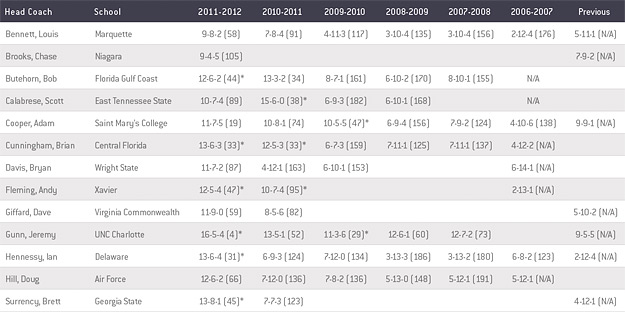In men’s soccer, top seeded North Carolina triumphed in the 2011-2012 Men’s NCAA Division I Soccer tournament, but this year’s College Cup was not without unpredictability. Most notably, Jeremy Gunn’s unseeded UNC Charlotte squad strung together a memorable Cinderella run that culminated with a Tar Heel State David and Goliath showdown in the tournament’s final. The 49ers’ success may have shocked some fans, but it certainly didn’t surprise anyone who had noticed the team’s steady improvements under Gunn’s leadership. In each of his five years at the helm, Charlotte notched a significant program milestone: its first ever A-10 championship game appearance, its first national ranking and NCAA appearance in over a decade, its first A-10 regular season championship, and now College Cup runners-up. Such success prompted Stanford to come calling, and on December 21, Gunn accepted the Cardinal’s head coaching position.
Though not on as dramatic a scale, a number of other coaches across D-I have provided jolts to previously underachieving programs. Andy Fleming of Xavier and Ian Hennessy of Delaware each turned squads coming off two-win seasons into 2011-2012 NCAA tournament participants. For Fleming, the two appearances in his only two seasons as head coach are the only two appearances in school history. For Hennessy, the Blue Hens’ 2011-2012 appearance marks its first in 41 years.
While some coaches have done it with few, others have done it with nothing. Scott Calabrese of East Tennessee State and Bob Butehorn of Florida Gulf Coast have seen great success with infant programs. Calabrese’s hopes for a follow-up NCAA appearance were dashed in the Atlantic Sun finals by Butehorn’s Eagles, who punched their tickets this season after back-to-back Atlantic Sun regular season titles.
Table 1 highlights coaches who took over non-traditional powerhouse programs after 2006 and have ushered in significant and steady successes, as defined by their record and RPI.
Table 1 — Success Since 2006 in Men’s Soccer (non-traditional powerhouse programs), Measured by Performance & RPI

Turning to women’s soccer, young head coaches have made similar turnarounds at programs that had previously undergone mediocre or losing seasons. In just his second season, Phil McNamara brought an Ohio Valley championship and NCAA appearance to a Tennessee-Martin squad that had gone 9-7-0 with a 215 RPI.
in 2009-2010, after his Skyhawks went 14-7-2 with an RPI of 116 this past season. Scott Juniper of UC Irvine, posting a 14-4-3 record and 26 RPI, took the Anteaters to their second consecutive NCAA tournament, an achievement almost unthinkable after a 3-13-1 season prior to his 2007 arrival. Taking over for a Florida International team that had gone 5-12-0 in 2006-2007, Thomas Chestnutt followed up consecutive 11-win seasons with 13 wins and an NCAA tournament appearance in 2011-2012. Suzie Grech’s Western Michigan squad’s 14 wins this past season are the most in school history, and Grech has consistently increased her team’s RPI in each of the three seasons since her hiring. Roberto Mazza has also steadily upped Arkansas-Pine Bluff’s win totals in each of his five seasons. Following an NCAA appearance this year, Mazza accepted an offer to coach at Louisiana-Monroe.
In field hockey, Neil Macmillan’s Ohio Bobcats finished a successful 2011-2012 campaign with 19 wins, second most in school history and tied for the most in MAC history. Ohio reached the NCAA tournament for the third time in its program’s existence, the second since Macmillan was hired following a 7-15 2004-2005 season. Meanwhile at Monmouth, Carli Figlio’s Hawks have steadily improved over her five-year tenure since posting a 4-12 record in 2007-2008. Monmouth has reached the Northeast Conference finals and increased its RPI rating in each of the past three seasons. Josette Babineau of Maine has also guided her Black Bears to three consecutive America East conference tournaments. In each of her five seasons, Maine has upped its win total from the previous year, culminating in a 16-win season in 2011.



